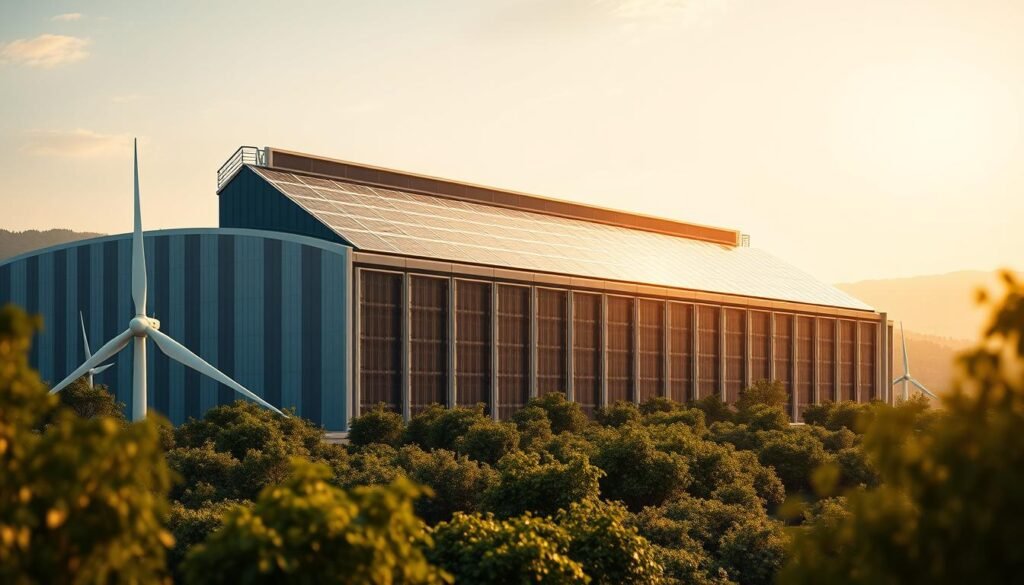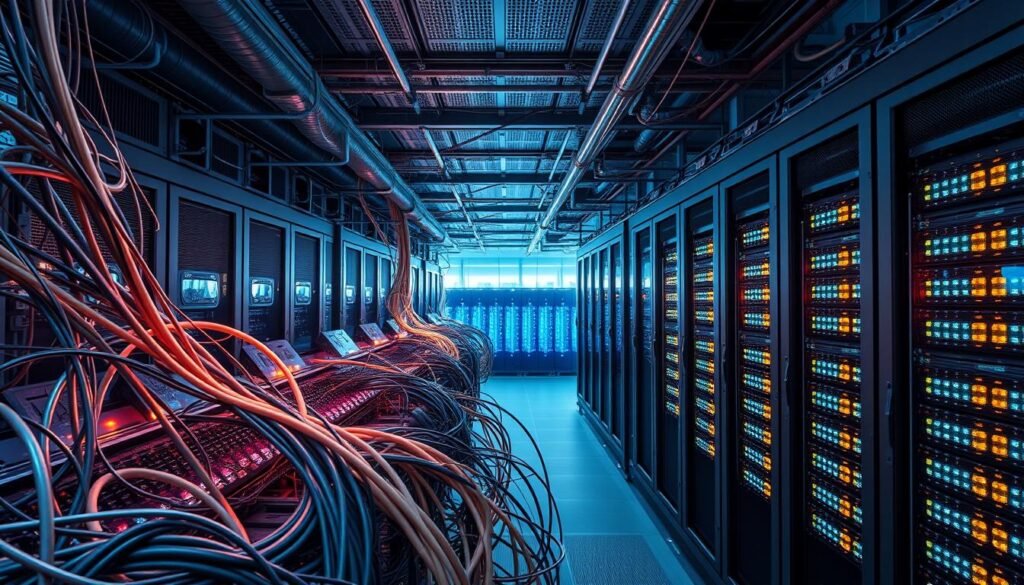“The future belongs to organizations that can turn today’s information into tomorrow’s insight.” – IBM’s former CEO Ginni Rometty perfectly captures the essence of our current technological revolution.
A big change is happening in digital infrastructure. Generative AI infrastructure needs are pushing for big changes in tech. McKinsey says global capacity demand could grow 19-22% each year until 2030, hitting up to 219 gigawatts.
This AI data center transformation is more than just updates. Your company needs to rethink power use, cooling, and how it works. By 2030, AI workloads will need about 70% of all capacity.
Generative apps will need about 40% of future computing power. These changes touch every part of your digital plan. They affect where you are in the world and how you compete in the future economy.
Key Takeaways
- Global capacity demand will grow 19-22% annually through 2030, reaching 171-219 gigawatts
- Artificial intelligence workloads will account for 70% of total capacity requirements by 2030
- Generative applications will represent 40% of overall demand in the coming decade
- Infrastructure decisions made today determine your competitive position tomorrow
- Power consumption and cooling systems require complete operational redesign
- Geographic distribution strategies must adapt to new computational requirements
Generative AI Surge Triggers Massive Infrastructure Overhaul
Your data center infrastructure is changing fast because of generative AI. The need for computing power to train and run large language models is fundamentally different from before. This means you need special hardware and cooling systems to handle the high power use.
The scale of this change is huge. AI infrastructure growth is happening so fast, it’s challenging old ways of planning. Your company needs to get ready for new infrastructure demands that will change the data center world.
Market Growth Statistics and Projections
Right now, we need 60 GW of data center power globally. But, experts say we’ll need 171-219 GW by 2030. In the best-case scenario, demand could hit 298 GW.
The generative AI market expansion is driving this rapid growth. AI-ready capacity is expected to grow by 33% every year from 2023 to 2030. This is the fastest growth in infrastructure we’ve seen, even faster than cloud computing.
| Year | Current Capacity (GW) | Conservative Projection (GW) | High-Growth Scenario (GW) |
|---|---|---|---|
| 2023 | 60 | 60 | 60 |
| 2026 | – | 105 | 140 |
| 2030 | – | 171-219 | 298 |
Major Tech Companies Leading the Charge
Hyperscale providers are spending billions to meet this demand. Amazon Web Services, Microsoft Azure, and Google Cloud are leading massive expansion initiatives in many places. They know that generative AI needs special infrastructure.
Your partnerships should be with these leaders who get AI workload needs. They’re building facilities with better power and cooling for AI’s computing needs.
AI Data Center Expansion Reaches Record Investment Levels
Your investment choices are now part of a trillion-dollar ai data center expansion world. This sector has seen more money than ever before. Big deals, like Blackstone and Digital Realty’s $7 billion partnership, show the huge money needed for AI.
Investment funds worldwide are fueling the sector’s growth. It’s estimated that over a trillion dollars will be needed. This is the biggest change in tech history.
North American Market Developments
Northern Virginia is known as the “data capital of the world.” Despite low vacancy rates, finding space is tough. This makes infrastructure investment trends more expensive.
Because of power issues, new areas like Atlanta, Phoenix, and Dallas are getting more money. They have better power and lower costs.
International Expansion Strategies
European cities like Frankfurt and Paris are becoming key for ai data center expansion. The Blackstone-Digital Realty deal focuses on these places. Think about data laws and local rules when expanding abroad.
Asian markets, like Singapore, Tokyo, and Sydney, are also getting a lot of investment. They’re important for AI in the region.
Regional Investment Distribution
Investments are spread out across the globe. Your investment strategy should match these infrastructure investment trends. This helps you stay competitive.
| Region | Investment Volume (Billions) | Key Markets | Growth Rate |
|---|---|---|---|
| North America | $450 | Northern Virginia, Dallas, Phoenix | 35% |
| Europe | $280 | Frankfurt, Paris, London | 42% |
| Asia Pacific | $320 | Singapore, Tokyo, Sydney | 38% |
| Other Regions | $150 | São Paulo, Mumbai, Dubai | 28% |
Temporary AI Data Centers Provide Immediate Capacity Solutions
Temporary AI data centers are the quickest way to get the computing power needed for AI. Traditional construction takes two to three years. But, these rapid-deployment solutions fill the gap between demand and supply. Your team can get AI-ready infrastructure in weeks, not years.
The modular way changes how we deploy data centers. Speed becomes your competitive advantage with these quick solutions. They give you instant access to top-notch computing resources.
Rapid Deployment Methodologies
Today’s rapid deployment uses prefabricated modules and containers. This method cuts down installation time. Your setup can use mobile power and standard parts that fit together easily. This way, you avoid long construction times and regulatory hold-ups.
Containerized data centers come ready with cooling, power, and network. You can start using them in weeks, not months. This lets you start AI projects right away while your permanent setup is built.
Cost-Effectiveness Analysis
Though temporary AI data centers cost more per unit, they offer immediate revenue generation opportunities. Being first to market can make up for the extra costs. This gives you a competitive edge and faster market entry.
The financial model changes to focus on operational flexibility. You get advanced AI infrastructure without huge upfront costs. This lets you strategically allocate resources for various projects while your permanent setup is built.
Hyperscale Data Centers Dominate AI Infrastructure Landscape
Your AI infrastructure choices must consider the dominance of hyperscale data centers. Cloud providers now own over half of the world’s AI-ready data center space. This shift changes how you plan your AI strategy.
By 2030, 60-65% of AI workloads in Europe and the U.S. will run on CSP and hyperscaler infrastructures. This change is a massive transformation in global computational power distribution.
Specialized providers like CoreWeave show the market’s growth. By July 2024, CoreWeave had about 45,000 GPUs and plans to expand to 28 locations. This rapid growth highlights the unprecedented demand for AI infrastructure.
Major Cloud Provider Facility Expansions
Amazon Web Services is expanding its facilities for AI workloads. These new facilities are designed for high-density computing needs of machine learning. Your planning should account for AWS’s strategic positioning in AI-optimized regions.
AWS is investing in dedicated AI zones with better networking. These zones offer more computing power than traditional data centers.
Microsoft Azure’s Strategic Global Growth
Microsoft Azure is expanding its cloud infrastructure for AI across continents. These regions meet the unique needs of generative AI. Your organization benefits from Azure’s efforts to reduce AI latency.
Azure’s global reach ensures AI applications are closer to users. This reduces response times and enhances user experience.
Google Cloud’s Technology-Focused Investments
Google Cloud focuses on custom silicon and advanced cooling for AI. These innovations boost AI performance while saving energy. Your AI strategy should consider Google’s specialized hardware for certain tasks.
Google’s approach balances efficiency with environmental care. This balance is key as AI workloads grow worldwide.
Energy Consumption Crisis Emerges from AI Workload Demands
Your plans to grow AI infrastructure face a big challenge: power consumption challenges are hitting crisis levels worldwide. The fast growth of AI apps has led to a huge energy demand. This demand is now higher than what power systems can handle.
Data centers, once okay with their power use, now need much more electricity. This change is a big shift in how we plan for energy.
Traditional data centers used 220-330 TWh of power in 2021. That’s only 0.9-1.3% of the world’s electricity. But AI apps are pushing these numbers too high.
Power Grid Strain Across Major Markets
Utilities in big tech areas are putting the brakes on new data center projects. Ireland has stopped new grid connections in Dublin until 2028 because of power issues. Similar problems are happening in Northern Virginia, Singapore, and Amsterdam.
When picking a location for your data center, remember the power grid limits. Power availability is as important as fiber and land costs. Some places require data centers to generate their own power or show they use renewable energy before they can connect.
AI Workload Energy Use Projections
The growth in rack power densities shows the scale of the ai workload energy use crisis. Training big models like ChatGPT can use over 80 kW per rack. Nvidia’s GB200 chip might need up to 120 kW per rack.
| Year | Average Power Density (kW per rack) | AI Training Workloads (kW per rack) | Projected Growth |
|---|---|---|---|
| 2021 | 8 kW | 15-25 kW | Baseline |
| 2024 | 17 kW | 80+ kW | 112% increase |
| 2027 | 30 kW | 120+ kW | 275% increase |
Your energy plan needs both quick fixes and long-term deals with green energy providers. AI training’s ups and downs make it hard to manage power. You’ll need smart grid management and energy storage to handle this.
Sustainable Data Centers Become Competitive Necessity
Your data center’s green efforts now affect your ability to win customers, get funding, and pass regulatory checks. Sustainable data centers are now key to staying competitive. Companies that ignore sustainability struggle to attract big clients and meet investor demands.
The market is pushing for better environmental performance. Companies like Microsoft are making bold moves, like using nuclear energy. This shows how important clean energy is for costs and meeting global rules.

Implementation Strategies
Renewable-powered data centers need smart energy systems. They must balance green energy with AI needs. Your plan should include using fuel cells, batteries, and local green energy. Some are buying sites near power plants for steady clean energy.
Small modular reactors (SMRs) are a future solution for constant clean power. These new nuclear techs offer the reliability AI needs and meet strict green standards.
Advanced Technology Integration
Green data center technology is more than just green energy. It includes cool systems that reuse waste heat and efficient hardware. These steps cut costs and boost green performance.
AI systems adjust resources based on green energy. This smart use of clean energy keeps AI services running smoothly.
Strategic Business Commitments
Companies’ green promises are now key to winning customers and investors. Your green record shapes your market standing, from deals to funding. Sustainable practices are vital for your business to thrive in green markets.
Modular Data Centers Revolutionize Deployment Speed
Speed-to-market demands are driving the adoption of modular infrastructure. Your organization can now deploy AI-ready capacity in weeks, not years, thanks to factory-built solutions. This change meets the urgent need for quick infrastructure scaling as AI workloads grow across industries.
Capital spending on data center procurement and installation is expected to hit $250 billion by 2030. Modular construction is gaining more investment. It’s known for speeding up deployment while keeping quality high.
Factory-Built Components Deliver Superior Quality Control
Prefabricated infrastructure has big advantages over traditional building. It offers controlled manufacturing environments, avoiding weather delays and site-specific issues. Quality control in factories ensures consistent performance across installations.
Construction waste can be cut by up to 90% compared to traditional builds. Standardized components are tested before shipping, cutting down on field commissioning time. This makes your project timeline more predictable, with fewer variables affecting completion dates.
Adaptive Capacity Meets Growing AI Demands
Modular data centers offer scalability and flexibility. They allow for adding capacity without disrupting current operations. You can start small and grow as AI workloads increase.
Standardized configurations optimize performance for specific AI workloads. This avoids the usual issues of over- or under-provisioning. It supports both temporary and permanent capacity needs, giving you strategic flexibility for market growth and competitive responses.
Cloud Hardware Trends Drive Equipment Innovation
Equipment makers are creating new hardware to meet AI needs. Cloud hardware trends are making computers work better and use less power. To stay ahead, your tech investments need to keep up with these changes.
GPU Architecture Requirements
Advanced GPU architecture is changing how processors are made for AI. Modern GPUs are great at handling lots of tasks at once, which is key for AI. They also use special chips that work well for AI but don’t use too much power.
When picking hardware, think about processors that can handle a lot of work. These processors get very hot but perform incredibly well.
Cooling Technologies
New cooling systems are needed for today’s AI processors. Direct-to-chip technology can handle up to 120 kW of power. Your cooling plan should look at different liquid cooling methods to find the best one.
| Cooling Technology | Power Density Range | Deployment Complexity | Efficiency Rating |
|---|---|---|---|
| Rear-Door Heat Exchangers | 30-50 kW | Low | Good |
| Direct-to-Chip | 60-120 kW | Medium | Excellent |
| Liquid Immersion | 100+ kW | High | Superior |
Network Infrastructure
New network tech aims to cut down on delays and boost speed. AI tasks need to move lots of data fast. Your network setup must handle these big data moves.
The move to 48-volt power supply units is a big step up. These units cut energy loss by 25% compared to old 12-volt systems. This means they can handle more power and save money on costs.
Your plan for new equipment should focus on being flexible for future upgrades.
Data Sovereignty EU Cloud Regulations Shape Global Strategy
Your AI strategy now faces a complex web of EU cloud rules. These rules are making companies choose hybrid and private cloud solutions. They offer more control over where data is processed and stored.
Cloud rebalancing is a big trend now. It means moving AI workloads from public clouds to on-premises data centers. This way, companies can better follow rules and stay efficient.

Compliance Framework Requirements
Today’s compliance rules need smart data governance in AI. Your company must control data location, processing, and transfers across borders.
Important compliance points include:
- Data residency controls that say where AI training data can be stored
- Processing location restrictions for sensitive workloads
- Audit trail capabilities for regulatory reporting
- Emergency access procedures that follow local laws
Regional Data Localization Impact
Regional data rules go beyond just where data is. Your design must fit different national rules that change AI system architecture.
These rules affect who you choose to work with, your team, and how you operate. Your strategy should be ready for new rules that might limit data movement even more.
Private data centers are becoming increasingly attractive as companies want full control over their AI while following new rules.
Financial Markets Signal Long-Term Infrastructure Transformation
The mix of artificial intelligence and infrastructure investment is leading to a huge investment wave. Your company needs to understand this new financial scene. More than a trillion dollars in investment will be needed in the AI world over the next ten years.
This big investment change shows a new way for financial markets to see tech infrastructure. Old ways of measuring returns are being replaced by strategic investments. These focus on long-term gains over quick profits.
Private Equity Investment Surge
Private equity firms are at the forefront of AI infrastructure investment, with record-breaking deals. The Blackstone and Digital Realty $7 billion transaction shows the huge amount of private money going into this area.
Your funding plan should be ready for this competitive market. Deals for private equity data centers are becoming more common. This is because smart investors see the long-term benefits of AI infrastructure.
What’s driving private equity interest includes:
- Predictable revenue streams from long-term cloud service contracts
- Scalable asset base that can grow with AI demand
- Strategic positioning in the AI value chain
Public Company Capital Allocation
Public tech companies are spending unprecedented parts of their budgets on data center growth and AI hardware. Your analysis must consider these huge investments from well-funded rivals.
Big companies now see AI infrastructure as essential, not just an upgrade. This means your investment choices should focus on infrastructure to stay competitive in your market.
The market’s excitement brings both chances and challenges for your company. You can get funding for projects that old ROI models wouldn’t support. But, you must act fast before the market shifts or competition gets even fiercer.
Supply Chain and Workforce Challenges Threaten Growth Pace
Expanding your AI infrastructure is getting harder due to supply chain challenges and workforce shortages. These issues are slowing down project timelines. Even with a lot of investment, physical limits are holding back data center growth.
Critical Component Shortages
Big equipment makers are dealing with huge backlogs. Orders for key parts can take 12 to 24 months. Customized electrical switchgear and power distribution systems are facing the biggest delays. High-capacity transformers, advanced cooling systems, and AI-optimized servers are waiting the longest.
You need to plan ahead for parts. Order them early to avoid delays. Working with several suppliers can help when one can’t meet demand.
Specialized Talent Acquisition Issues
There’s a huge demand for AI experts, but not enough people. Workforce shortages are hitting hard for data center engineers and AI operators. Companies are now paying more and training better to get the right people.
Working with schools is key to finding the right talent. Many companies are also training their own staff to fill the gap.
Regulatory Approval Delays
Getting permits for power, environment, and construction is taking longer. Regulatory delays are adding months to projects. Governments are figuring out how to oversee AI infrastructure. Plan your project with these delays in mind.
| Challenge Category | Average Delay | Primary Impact | Mitigation Strategy |
|---|---|---|---|
| Electrical Equipment | 18-24 months | Project postponement | Early procurement planning |
| Skilled Labor | 6-12 months | Construction delays | Training partnerships |
| Regulatory Approval | 8-16 months | Timeline uncertainty | Early permit applications |
| Cooling Systems | 12-18 months | Capacity limitations | Alternative supplier networks |
Conclusion
Your organization is at a key moment. Planning for the AI infrastructure future will shape your success for years to come. The shift in data centers is as big as the internet’s arrival.
The industry faces a big challenge with not enough capacity. Your choices on power, cooling, and location must meet today’s needs and tomorrow’s growth. It’s a balancing act.
Supply chain issues and a lack of workers will slow down projects. Your plan should handle these problems and find good partners in tech and energy.
The time to get ahead in AI is running out fast. Those who act early are getting the best spots, deals, and partnerships. They’re setting the market’s course.
Your success in this change depends on tackling all infrastructure issues together. You need to manage energy, follow rules, and keep operations smooth for AI to grow.
Companies that tackle these challenges now will lead in the AI world. Your choices today will decide if you’ll succeed or face challenges in the digital future.



